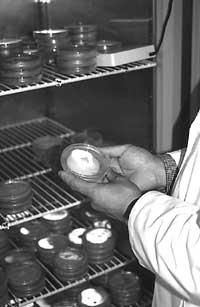Text written in Basque and translated automatically by Elia without any subsequent editing. SEE ORIGINAL
Research lines
Agriculture
Horticulture
- Cultivation techniques: The main objective is to improve production technologies, especially irrigation systems and planting techniques.
- Evaluation of vegetables: The selection and development of the vegetables that best adapt to the local climatological and ecological conditions is encouraged.
- Selection and improvement: Once the native varieties are typified, the selection and improvement of the varieties that meet these characteristics is sought. In this work we work, for example, with Gernika pepper, Tolosa bean or Ibarra peppers.
 Azelgak.SIMA
Azelgak.SIMA - Industrial horticulture: is a project that is being carried out in collaboration with the Provincial Council of Alava. It is about looking for alternatives to the products used in the traditional Alava cultivation (potato, beet or rye). Especially for products that are not sold fresh, frozen vegetables, preserves, etc.
- Landless crops: A study of the new types of substrates is carried out, determining the amounts of water and the physico-chemical conditions necessary for each type of substrate. Through these techniques, the benefits multiply because vegetables are only given what they need to grow, no more or less.
Agriculture
Production of plants
- Genetic improvement: The potato is mainly worked. They try increasingly better varieties combining the traditional classic cruise with new biotechnology techniques. The genetic improvement of the varieties must be done taking into account, in addition to the morphological characteristics, the physical-chemical and genetic characteristics. Formerly the potato varieties were very generic and served for anything, while at present the different varieties are better defined according to the different uses that are going to give them: frying potato, mashed, freezing, fresh consumption, etc.
- Variety testing: Once a new and good variety is obtained, it must be exhibited and sold to the market, for which experimental plots are placed to show the other technicians the characteristics of this variety.
 Potato germplasm.A. Related information
Potato germplasm.A. Related information - Germplasm Bank: This bank preserves native varieties of beans, corn, peppers, chilli beans, potatoes and other vegetables. It is a project of great importance for the local wealth. In this bank we can find hundreds of varieties.
- Agronomy: The soils, climate and techniques most suitable for plant growth are analyzed. Currently we are working mainly on irrigation systems.
- Phytopathology: They try to identify, treat and, if possible, predict plant diseases. For example, in beet fields a virus usually produces a serious disease (Rubia). The virus spreads through the lice and its life cycle depends on time. The capture of lice is done by traps that allow us to know the most suitable time for the use of insecticides, informing farmers through the media to take action in the fields of beet.
Forestry and natural resources
FORESTRY
- Genetic improvement: It focuses mainly on radiata pine or insignis, the only species that currently interests the sector.
- Introductions: We are working with new tree species of forest utility.
 Radiata pine.J. Larrañaga
Radiata pine.J. Larrañaga - Indigenous genetic resources: Currently they work with oak species, within the macroproject that is being carried out at European level, analyzing the origin and genetic distances of oaks from different places.
- Technologies: Pruning techniques, fertilization systems, etc. so that tree trunks are as direct and hard as possible.
- Forest uses: Damage and transformations resulting from forest activity are analyzed. For example, once the trees are pruned, the branches remain in the forest because they have no value. This causes phytosanitary problems and increases the risk of fires.
Natural resources
- Forage systems: We analyze the plant or herbaceous species that best adapt to the climatic and edaphological conditions of our environment.
- Control of fertilization systems: We analyze the different types of fertilization in pastures and meadows, paying special attention to the possible consequences of these fertilizations. This is because if these processes result in high nitrate leaching, there is a high risk of aquifer contamination.
LIVESTOCK
Animal health
- Applied epidemiology: After the analysis of samples sent by farmers and veterinarians, diagnoses are made. Blood tests of native cows and sheep are also closely monitored.
- Technological development: Diagnostic techniques are renewed and the development of different diseases is closely analyzed. This information channels new treatments and implements disease prevention systems.
- Zoonosis section: projects are carried out in collaboration with the Department of Health. Different diseases that can pose a risk to humans are analyzed. These diseases are transmitted by capers that act as vectors. Throughout the lifecycle of capers, animals and humans can be hostels so special attention is paid to these insects.
Animal production
- Genetic improvement: Genetic improvements of the various cattle and sheep breeds of Latxa breed are promoted. These projects require great collaboration and coordination between researchers, ranchers and veterinarians. The data of the cattle are processed through computer programs to be able to select the best copies. The management and advice of genealogical books is also carried out.
- Recovery programs:Recovery projects for endangered breeds.
 Latxas sheep.A. Related information
Latxas sheep.A. Related information - Food: A study of the herbaceous species found in high mountain pastures is carried out in order to obtain feed or food that would complement the sheep food on the mountain during the summer.
Buletina
Bidali zure helbide elektronikoa eta jaso asteroko buletina zure sarrera-ontzian











